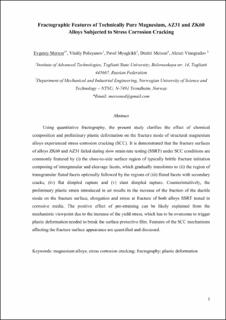| dc.contributor.author | Merson, Evgeniy | |
| dc.contributor.author | Poluyanov, Vitaliy | |
| dc.contributor.author | Myagkikh, Pavel | |
| dc.contributor.author | Merson, Dmitri | |
| dc.contributor.author | Vinogradov, Alexey | |
| dc.date.accessioned | 2021-09-07T05:13:17Z | |
| dc.date.available | 2021-09-07T05:13:17Z | |
| dc.date.created | 2020-09-15T18:18:17Z | |
| dc.date.issued | 2020 | |
| dc.identifier.citation | Materials Science & Engineering: A. 2020, 772 1-13. | en_US |
| dc.identifier.issn | 0921-5093 | |
| dc.identifier.uri | https://hdl.handle.net/11250/2773868 | |
| dc.description.abstract | Using quantitative fractography, the present study clarifies the effect of chemical composition and preliminary plastic deformation on the fracture mode of structural magnesium alloys experienced stress corrosion cracking (SCC). It is demonstrated that the fracture surfaces of alloys ZK60 and AZ31 failed during slow strain rate testing (SSRT) under SCC conditions are commonly featured by (i) the close-to-side surface region of typically brittle fracture initiation composing of intergranular and cleavage facets, which gradually transforms to (ii) the region of transgranular fluted facets optionally followed by the regions of (iii) fluted facets with secondary cracks, (iv) flat dimpled rapture and (v) slant dimpled rapture. Counterintuitively, the preliminary plastic strain introduced in air results in the increase of the fraction of the ductile mode on the fracture surface, elongation and stress at fracture of both alloys SSRT tested in corrosive media. The positive effect of pre-straining can be likely explained from the mechanistic viewpoint due to the increase of the yield stress, which has to be overcome to trigger plastic deformation needed to break the surface protective film. Features of the SCC mechanisms affecting the fracture surface appearance are quantified and discussed. | en_US |
| dc.language.iso | eng | en_US |
| dc.publisher | Elsevier | en_US |
| dc.rights | Attribution-NonCommercial-NoDerivatives 4.0 Internasjonal | * |
| dc.rights.uri | http://creativecommons.org/licenses/by-nc-nd/4.0/deed.no | * |
| dc.title | Fractographic features of technically pure magnesium, AZ31 and ZK60 alloys subjected to stress corrosion cracking | en_US |
| dc.type | Peer reviewed | en_US |
| dc.type | Journal article | en_US |
| dc.description.version | acceptedVersion | en_US |
| dc.source.pagenumber | 1-13 | en_US |
| dc.source.volume | 772 | en_US |
| dc.source.journal | Materials Science & Engineering: A | en_US |
| dc.identifier.doi | 10.1016/j.msea.2019.138744 | |
| dc.identifier.cristin | 1830221 | |
| dc.description.localcode | "© 2019. This is the authors’ accepted and refereed manuscript to the article. Locked until 28.11.2021 due to copyright restrictions. This manuscript version is made available under the CC-BY-NC-ND 4.0 license http://creativecommons.org/licenses/by-nc-nd/4.0/ " | en_US |
| cristin.ispublished | true | |
| cristin.fulltext | postprint | |
| cristin.qualitycode | 2 | |

